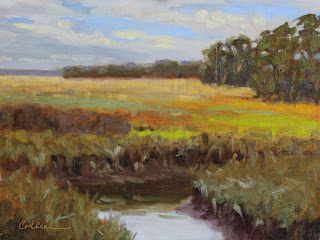Having been a self described "workshop junkie", this has also diminished. In the last 16 years I have taken well over 50 workshops, the majority of which have been great. After a point I realized that I had mostly heard it all, and it was up to me to dig in and put all of that good instruction into practice. This year I took one workshop and will probably do that from here on out. I don't want to exclude the possibility of learning something new, and I love the camaraderie of a good class and a chance to get to know an artist that I admire. However there is no reason for me to go crazy anymore.
In July I attended a workshop in Maine with my good friend Capey. It was insanely hot, a disappointment, but the instructor was great (Ann Larsen). She suggested, after a brief quick small demo the last day, that if each of us did this daily for a month we would be better painters. It was not the first time I had heard this advice and I tucked it away as I always do. On the way home, Capey informed me that we would in fact be doing this in August. A good month because neither of us had any travel plans or other pressing commitments. I had no choice but to reluctantly agree.
So we did it. I made the awful decision to post my daily paintings on Insta and FB to make sure that should I not succeed I would face public humiliation. My 12 followers would have been forgiving I'm quite sure, but for me it upped the game.
Here is what I experienced, and assuming you wouldn't be reading this if you weren't a painter, I will proceed to share.
Making the commitment is obviously the key, and planning it at a time when it is feasible. Pairing off with a friend, putting it on social media, and/or participating in an organized event creates incentive. I remember a few years ago when Strada sponsored one and the winner got a free easel. Capey and I enjoyed discussing our daily efforts, and this was amazingly supportive, as if we had been painting together.
Thinking of something to paint every day for a month was more difficult for me than actually painting. I planned each day's painting a day ahead so I didn't have that hurdle the day of.
This was a chance to review all of my neglected reference photos, the ones I always thought I would paint but hadn't after many years. I really enjoyed this part. I painted some really ridiculous things and didn't worry about it one bit. I allowed myself to get way out of my comfort zone. I also took this opportunity to experiment with gouache, not my usual medium, and this helped me get more comfortable with it.
I mostly painted on pieces of oil primed linen for the oils or good paper for gouache. The cost of this was low so nothing was too precious, yet I could enjoy the process. I could always mount any favorites and put them in frames, but maybe I won't. I could always go back to revise some of them, but maybe I won't.
Now that I have finished this project I wonder if I am a better painter. I'm not sure that is the case. After all, it was only one month. What I do know is that after a long dry-ish spell I am happy to go into my studio again. It is a more welcoming and familiar place. That alone will make me a better painter in the long run.
Thanks for reading. I am posting a few from the 31 paintings. They are all on Instagram (cpainter100) or my business Facebook page (Colleen Parker Fine Art) if you would like to see the rest them. It was fun, try it!
My best attempt at gouache. A chair in our bedroom.
Like nothing I have ever done, but I always loved my photo of this ghost crab on the SC coast.
This lava lamp is in the Natural History Museum in the Smithsonian Institute, one of my favorite places.


















































